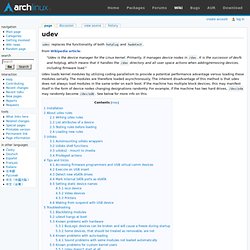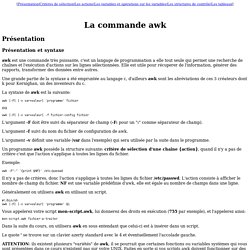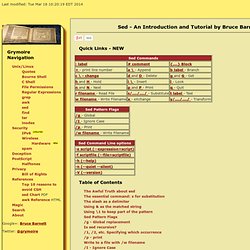

Udev. Udev replaces the functionality of both hotplug and hwdetect.

From Wikipedia article: "Udev is the device manager for the Linux kernel. Primarily, it manages device nodes in /dev. It is the successor of devfs and hotplug, which means that it handles the /dev directory and all user space actions when adding/removing devices, including firmware load. " Udev loads kernel modules by utilizing coding parallelism to provide a potential performance advantage versus loading these modules serially. Installation Udev is now part of systemd and is installed by default on Arch Linux systems. Writing udev rules. By Daniel Drake (dsd) Version 0.74 The most recent version of this document can always be found at: Contents Introduction About this document udev is targeted at Linux kernels 2.6 and beyond to provide a userspace solution for a dynamic /dev directory, with persistent device naming.

Over the years, the things that you might use udev rules for has changed, as well as the flexibility of rules themselves. This document assumes that you have udev installed and running OK with default configurations. This document does not cover every single detail of rule writing, but does aim to introduce all of the main concepts. This document uses various examples (many of which are entirely fictional) to illustrate ideas and concepts. History The concepts Terminology: devfs, sysfs, nodes, etc. A basic introduction only, might not be totally accurate. On typical Linux-based systems, the /dev directory is used to store file-like device nodes which refer to certain devices in the system.
Why? LinuxLive USB Creator. Linux From Scratch - traduction française. Filesystem Hierarchy Standard. Purpose This section details the organization for manual pages throughout the system, including /usr/share/man.

Also refer to the section on /var/cache/man. The primary <mandir> of the system is /usr/share/man. /usr/share/man contains manual information for commands and data under the / and /usr filesystems. Manual pages are stored in <mandir>/<locale>/man<section>/<arch>. A description of each section follows: man1: User programs Manual pages that describe publicly accessible commands are contained in this chapter. Specific Options. Shell_v2.0.pdf (Objet application/pdf) Cours utilisateur UNIX : La commande awk. [Présentation|Critères de sélection|Les actions|Les variables et opérations sur les variables|Les structures de contrôle|Les tableaux] Présentation Présentation et syntaxe awk est une commande très puissante, c'est un langage de programmation a elle tout seule qui permet une recherche de chaînes et l'exécution d'actions sur les lignes sélectionnées.

Elle est utile pour récuperer de l'information, générer des rapports, transformer des données entre autres. Une grande partie de la syntaxe a été empruntée au langage c, d'ailleurs awk sont les abréviations de ces 3 créateurs dont k pour Kernighan, un des inventeurs du c. La syntaxe de awk est la suivante: awk [-F] [-v var=valeur] 'programme' fichier ou awk [-F] [-v var=valeur] -f fichier-config fichier L'argument -F doit être suivi du séparateur de champ (-F: pour un ":" comme séparateur de champ). L'argument -f suivi du nom du fichier de configuration de awk. Sed - An Introduction and Tutorial. Quick Links - NEW Table of Contents Copyright 1994, 1995 Bruce Barnett and General Electric Company Copyright 2001,2005,2007,2011,2013 Bruce Barnett All rights reserved You are allowed to print copies of this tutorial for your personal use, and link to this page, but you are not allowed to make electronic copies, or redistribute this tutorial in any form without permission.

Original version written in 1994 and published in the Sun Observer How to use sed, a special editor for modifying files automatically. There are a few programs that are the real workhorse in the UNIX toolbox. Sed is the ultimate stream editor. Anyhow, sed is a marvelous utility. Do not fret! Sed has several commands, but most people only learn the substitute command: s.